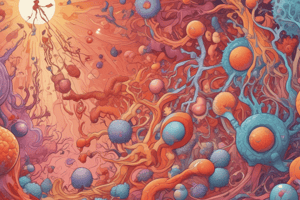Podcast
Questions and Answers
What triggers the migration of leukocytes from the bloodstream to sites of invasion?
What triggers the migration of leukocytes from the bloodstream to sites of invasion?
- DAMPs
- Inflammation (correct)
- Cytokines
- PAMPs
What does PAMP stand for?
What does PAMP stand for?
Pathogen-associated molecular patterns
TLRs are toll-like receptors found only on macrophages.
TLRs are toll-like receptors found only on macrophages.
False (B)
TLRs are a major group of ______ receptors.
TLRs are a major group of ______ receptors.
Match the following cell types with their roles in the innate immune system:
Match the following cell types with their roles in the innate immune system:
Flashcards are hidden until you start studying
Study Notes
Inflammation
- Inflammation concentrates defensive cells and antimicrobial molecules at sites of microbial invasion and tissue damage
- Inflammation triggers the migration of leukocytes from the bloodstream to sites of invasion, where they attack and destroy invaders
- Inflammation allows protective proteins, such as antibodies and complement components, to enter tissues and destroy invaders
Innate Immune System
- The innate immune system focuses defensive cells and proteins on sites of microbial invasion
- The innate immune system destroys invaders and repairs tissue damage
Exogenous and Endogenous Signals
- Exogenous signals: invading organisms, pathogen-associated molecular patterns (PAMPs)
- Endogenous signals: dead and dying cells, damage-associated molecular patterns (DAMPs)
Pattern Recognition Receptors (PRRs)
- PRRs recognize PAMPs and DAMPs on sentinel cells
- PRRs activate the innate immune system
Microbial Cell Walls
- Gram-positive bacteria: peptidoglycans, lipoteichoic acids
- Gram-negative bacteria: peptidoglycans, lipopolysaccharide (LPS)
- Acid-fast bacteria: glycolipids
- Yeasts: mannan- or β-glucan–rich cell walls
Viruses
- Viruses grow within infected host cells
- Main targets of antiviral PRRs: unique viral nucleic acids
Toll-Like Receptors (TLRs)
- TLRs are a type of PRR
- TLRs are expressed on sentinel cells, including macrophages, dendritic cells, and mast cells
- TLRs recognize PAMPs and activate sentinel cells
Signaling Pathways
- Myeloid differentiation response 88
- Mitogen-activated protein kinase kinase
- Interleukin receptor associated kinase
- Mitogen activated protein kinase
- Nuclear factor – kappa B
- Interferon regulatory factor 3
Other PRRs
- Retinoic acid inducible gene (RIG)-like receptors (RLRs)
- Nucleotide-binding oligomerization domain (NOD)-like receptors
Microbial Pathogen-Associated Molecular Patterns
- Lipopolysaccharides (LPS)
- Peptidoglycans
- Nucleic acids
Cytokines
- Cytokines are proteins that stimulate the inflammatory process
Studying That Suits You
Use AI to generate personalized quizzes and flashcards to suit your learning preferences.




